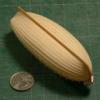-
Posts
13,303 -
Joined
-
Last visited
Content Type
Profiles
Forums
Gallery
Events
Everything posted by druxey
-

Hof van St Janskerke by niels wilhelm
druxey replied to niels wilhelm's topic in - Build logs for subjects built 1501 - 1750
Impressive sized model, Niels! A few larger photos would show off your work better. -
Remember that often curved logs were sawn into planking, so were selected according to shape for a particular plank. Power sawmills and planers were far in the future!
-
Welcome, Marshall, to yet another Canuck!
-

Echo by davec - FINISHED - cross-section
druxey replied to davec's topic in - Build logs for subjects built 1751 - 1800
Practice makes.... Looking very good, Dave!- 127 replies
-
Just caught this interesting build. Nice neat work!
- 35 replies
-
- allege darles
- wak
-
(and 2 more)
Tagged with:
-
Any shape may be planked, but to plank it well (in other words that the planks follow curves pleasing to the eye) is an art as well as a science. Also, the expanded plank shapes may seem strange when 'unwrapped'. Some will be quite 'S' shaped. You might get better insight by carving a solid hull, then lining out the planking until the lines appear fair and sweet, then lifting the expanded shapes from the surface. You will then have more confidence when 3D modeling on-screen. A very happy and healthy New Year as you enjoy your family as well as the complexities of planking.
-
Just catching up, DIck. Lovely work, as usual!
- 263 replies
-
- nave tonda
- round ship
-
(and 2 more)
Tagged with:
-
Which is what I was trying to say less bluntly!
-
Intereresting, but the concept is flawed. The degree of bevel will change along a strake of planking. It is not constant!
-

HMS Sphynx by TBlack - 1:64
druxey replied to TBlack's topic in - Build logs for subjects built 1751 - 1800
I hope that Volume IV provides all the missing information for you. -
This recent book on the Restoration Navy reappraises Samuel Pepys' role and the influence of his brother Prince James on the Restoration Navy. Now, this could have been presented in a dry and scholarly way, but Dr. David Davies' writing is lively and, at times, quite humorous. Nevertheless, while readable, the work is also scholarly with pages of end-notes and references. This book recently won the author the prestigious Anderson Medal for best non-fiction maritime writing, beating out 18 other entries. This book has also been awarded a Certificate of Merit from the Maritime Foundation in the Mountbatten Award ‘Best Book’ category, and their citation reads: This carefully researched and readable history makes a major contribution to understanding the little known but influential roles played by Kings Charles II and James II in promoting the development of the Royal Navy through major reforms, innovation and exploration. Historically authoritative, this original work provides an invaluable insight into the emerging concept of sea power. The author’s lucid style and original approach makes this period in the evolution of the Royal Navy accessible to a wide audience. Thoroughly recommended!
-

HMS Sphynx by TBlack - 1:64
druxey replied to TBlack's topic in - Build logs for subjects built 1751 - 1800
That's correct, TB. They are used for hoisting when rigging. -
Yes, the jaws of a parallel pliers do not 'pinch' like regular ones. The jaws stay parallel to each other through the whole opening range. See: https://www.amazon.ca/MAK-Parallel-Action-Inserts-Jewellery/dp/B01L1CSJMQ/ref=sr_1_1?gclid=Cj0KCQiA6IHwBRCJARIsALNjViUSdAvG0_WJHKGbzsJZkPvfbLJt7eYgeKIPD0epCwNVDC4pnayzUVsaAplSEALw_wcB&hvadid=254899150231&hvdev=c&hvlocphy=9000745&hvnetw=g&hvpos=1t1&hvqmt=b&hvrand=5763433321150160024&hvtargid=kwd-297781321436&hydadcr=24908_10283703&keywords=parallel+pliers&qid=1577154999&sr=8-1
-

HMS Sphynx by TBlack - 1:64
druxey replied to TBlack's topic in - Build logs for subjects built 1751 - 1800
Well, welcome back! What you have circled appear to be the Burton pendants of the standing rigging, not the slings. If you have a copy of Longridge's The Anatomy of Nelson's Ships, this will be clear in the beautiful perspective drawing of the fore top by G.F. Campbell between pages 212 and 213.
About us
Modelshipworld - Advancing Ship Modeling through Research
SSL Secured
Your security is important for us so this Website is SSL-Secured
NRG Mailing Address
Nautical Research Guild
237 South Lincoln Street
Westmont IL, 60559-1917
Model Ship World ® and the MSW logo are Registered Trademarks, and belong to the Nautical Research Guild (United States Patent and Trademark Office: No. 6,929,264 & No. 6,929,274, registered Dec. 20, 2022)
Helpful Links
About the NRG
If you enjoy building ship models that are historically accurate as well as beautiful, then The Nautical Research Guild (NRG) is just right for you.
The Guild is a non-profit educational organization whose mission is to “Advance Ship Modeling Through Research”. We provide support to our members in their efforts to raise the quality of their model ships.
The Nautical Research Guild has published our world-renowned quarterly magazine, The Nautical Research Journal, since 1955. The pages of the Journal are full of articles by accomplished ship modelers who show you how they create those exquisite details on their models, and by maritime historians who show you the correct details to build. The Journal is available in both print and digital editions. Go to the NRG web site (www.thenrg.org) to download a complimentary digital copy of the Journal. The NRG also publishes plan sets, books and compilations of back issues of the Journal and the former Ships in Scale and Model Ship Builder magazines.


